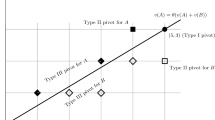Abstract
A sufficient condition is derived for a policy y to be a Condorcet winner, when the set of feasible policies is some subsety ofR N with non-empty interior. Voters are assumed to differ in some scalar characteristic w. The sufficient condition refers only to voters' preferences over the set of preferred policies (of the various other voters). This set is a one-dimensional curve inR N> . The condition is that the indifference curves of each typew through the preferred policyy * (v) of any typev all be collinear. If the condition holds, then the preferred policyy * (m) of the median type of voter will be a Condorcet winner. If there are only three types of voter, then the above condition is also necessary for the existence of a Condorcet winner.
Similar content being viewed by others
References
Atkinson A, Stiglitz J (1980) Lectures on public economics. New York: McGraw-Hill
Bergstrom T, Cornes R (1981) Gorman and Musgrave are dual-an antipodean theorem on public goods. Econ Letters 7: 371–378
Bergstrom T, Comes R (1983) Independence of allocative efficiency from distribution in the theory of public goods. Econometrica 51: 1753–1765
Bergstrom T, Goodman R (1973) Private demands for public goods. Am Econ Rev 63: 280–296
Bucovetsky S (1989) Choosing tax rates and public expenditures using majority rule. (unpublished)
Caplin A, Nalebuff B (1988) On 64% majority rule. Econometrica 56: 787–814
Coughlin P, Hinich M (1984) Necessary and sufficient conditions for single-peakedness in public economics. J Public Econ 25:161–180
Davis O, DeGroot M, Hinich M (1972) Social preference orderings and majority rule. Econometrica 40:147–157
Denzau A, Parks R (1977) Public sector preferences. J Econ Theory 14:454–457
Denzau A, Parks R (1979) Deriving public sector preferences. J Public Econ 11: 335–354
Enelow J, Hinich M (1984) The spatial theory of voting: an introduction. Cambridge University Press, Cambridge
Epple D, Filimon R, Romer T (1984) Equilibrium among local jurisdictions: towards an integrated treatment of voting and residential choice. J Public Econ 24:281–308
Glazer A, Grofman B (1988) Limitations of the spatial model. Public Choice 58:161–168
Gorman W (1953) Community preference fields. Econometrica 21:63–80
Grandmont J-M (1978) Intermediate preferences and majority rule. Econometrica 46: 317–330
Kramer G (1972) Sophisticated voting over multidimensional choice spaces. J Math Sociol 2: 165–180
Kramer G (1973) On a class of equilibrium conditions for majority rule. Econometrica 41: 285–297
Ordeshook P (1986) Game theory and political theory: an introduction. Cambridge University Press, Cambridge 1986
Plott C (1967) A notion of equilibrium and its possibility under majority rule. Am Econ Rev 57: 787–806
Rose-Ackerman S (1979) Market models of local government: exit, voting and the land market. J Urban Econ 6:319–337
Author information
Authors and Affiliations
Additional information
This paper is a revision of the first part of my earlier “Majority Rule with Multidimensional Economic Choices”. I thank Ted Bergstrom, David Donaldson, and Greg Dow for very valuable comments on versions of that earlier paper, without implicating them in this current incarnation.
Rights and permissions
About this article
Cite this article
Bucovetsky, S. Majority rule in multi-dimensional spatial models. Soc Choice Welfare 7, 353–368 (1990). https://doi.org/10.1007/BF01376283
Received:
Accepted:
Issue Date:
DOI: https://doi.org/10.1007/BF01376283




